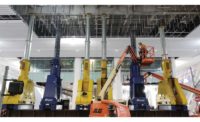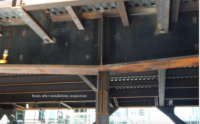The proposed bypass fix for the troubled Fremont Street girders of San Francisco’s Salesforce Transit Center calls for bolting 20-in.-wide steel cover plates above and below the area around each fractured bottom flange, like a 14-ft-long double splint. The proposed repair detail, presented to the board of the Transbay Joint Powers Authority on Dec. 13, has the unofficial support of the independent peer review panel established to oversee the work of the team investigating the cracks.
The panel will complete its detailed review of the proposed fix in the next several days and make its recommendation.
The panel, commissioned by the Metropolitan Transportation Commission in early October, is “in general concurrence” with the fix proposed by the transit center’s engineer-of-record, Thornton Tomasetti (TT), said Michael D. Engelhardt, the chair of the MTC panel, at the Dec. 13 meeting of the TJPA’s board of directors. “It’s a reasonable approach,” added Engelhardt, a professor of structural engineering at the University of Texas, Austin.
Engelhardt added that the panel will complete its detailed review of the proposed fix in the next several days and make its recommendation to the MTC and the TJPA.
As described by Bruce Gibbons, the TT managing principal in charge of the transit hub, the proposed bolted fix would only repair the compromised region, at the 8-ft-deep midspan of each 80-ft-long girder, by bypassing the welded area using the cover plate sandwich. In addition, 8-in.-tall plates would be bolted to each girder’s vertical stiffener.
Bottom Flanges To Regain Design Capacity
The fix would restore each bottom flange to its original design capacity, he said.
Gibbons also said the cracked girders had sufficient capacity to support the building’s dead and occupancy loads. The live loads were less than anticipated by the design and the midspan bending moments were less than anticipated, in part because of the thick roof slab, he said.
Additionally, “there was not a lot of deflection” when the fracture happened, added Gibbons. The girders deflected 0.75 in. to 1 in. after the fracture. “This was less than the girder was designed to deflect under full live loads,” he said.
In addition, the amount of load shed was 5% to 10% after the cracking. “Adjacent beams and columns were not overstressed,” he said. “There is no indication of overstressing of adjacent members.”
Nevertheless, the investigating team is testing the integrity of the bolted connections where the girders land on their columns.
In addition, at the board meeting, Robert S. Vecchio, CEO of forensic metallurgist LPI Inc., presented preliminary findings of LPI’s metallurgical investigation. He indicated the cracks started at the weld access holes. “We can’t assign a root cause” until the finite element analysis is complete. Findings will likely be presented at the next board meeting, in about a month.






Post a comment to this article
Report Abusive Comment